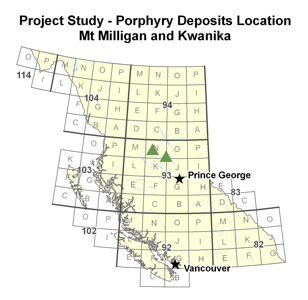Summary
 Exploration geochemistry in British Columbia has up to now relied on traditional methods such as stream sediment and soil geochemistry to detect metals dispersed mechanically and hydromorphically from out cropping sources. These methods have proven to be highly effective and there has been a long and impressive history of discoveries using them. As exploration maturity increases however, mining companies are faced with the challenge of exploring more and more in areas of transported cover where traditional methods are less effective or don't work at all. Much of the Central Interior of British Columbia is covered with a veneer of glacially derived sediments that completely mask the underlying bedrock. As a result, exploration companies have switched their focus from geochemical methods to a more geophysical approach that seeks to define favourable geology beneath the glacial cover using airborne magnetic, gravity, electromagnetic and radiometric techniques. Unfortunately these methods only provide indirect knowledge of the bedrock geology and ground geophysics is often necessary to validate the airborne geophysical results and define drill targets.
Exploration geochemistry in British Columbia has up to now relied on traditional methods such as stream sediment and soil geochemistry to detect metals dispersed mechanically and hydromorphically from out cropping sources. These methods have proven to be highly effective and there has been a long and impressive history of discoveries using them. As exploration maturity increases however, mining companies are faced with the challenge of exploring more and more in areas of transported cover where traditional methods are less effective or don't work at all. Much of the Central Interior of British Columbia is covered with a veneer of glacially derived sediments that completely mask the underlying bedrock. As a result, exploration companies have switched their focus from geochemical methods to a more geophysical approach that seeks to define favourable geology beneath the glacial cover using airborne magnetic, gravity, electromagnetic and radiometric techniques. Unfortunately these methods only provide indirect knowledge of the bedrock geology and ground geophysics is often necessary to validate the airborne geophysical results and define drill targets.
What is missing from the explorationist's toolkit is a geochemical method that can be used to follow up the airborne and ground geophysical targets that can provide a direct measurement of the trace element characteristics of a blind target. Such a method would prove invaluable for prioritizing drill holes and could significantly reduce the number of 'dry' holes drilled into geophysical targets thereby reducing a company's drilling risk.
Partial leach geochemistry has the potential to become an important part of future exploration programs in the covered areas of BC. Unfortunately little work has been done to optimize methods for typical BC environments and little of what has been done has not reached the public domain.
This project presents a case for carrying out two orientation surveys to test a range of commercially available partial leach methods on blind porphyry copper targets with the objective of optimizing sampling and analytical methods for two contrasting environments (i.e. logged vs unlogged, glacial outwash vs. till cover). Two orientation sites proposed are: The Central Zone at Serengeti's Kwanika project and the MBX and 66 Zone at Terrane Metal's Mt Milligan project.